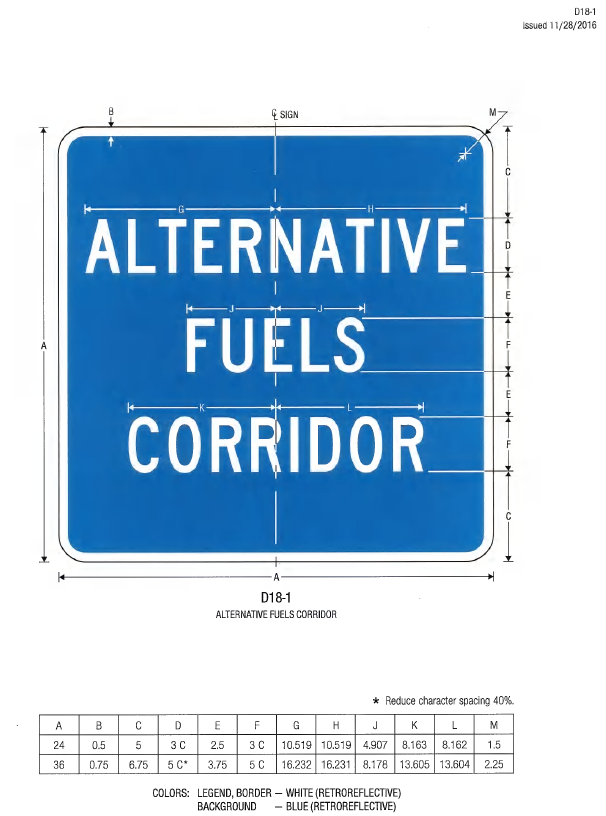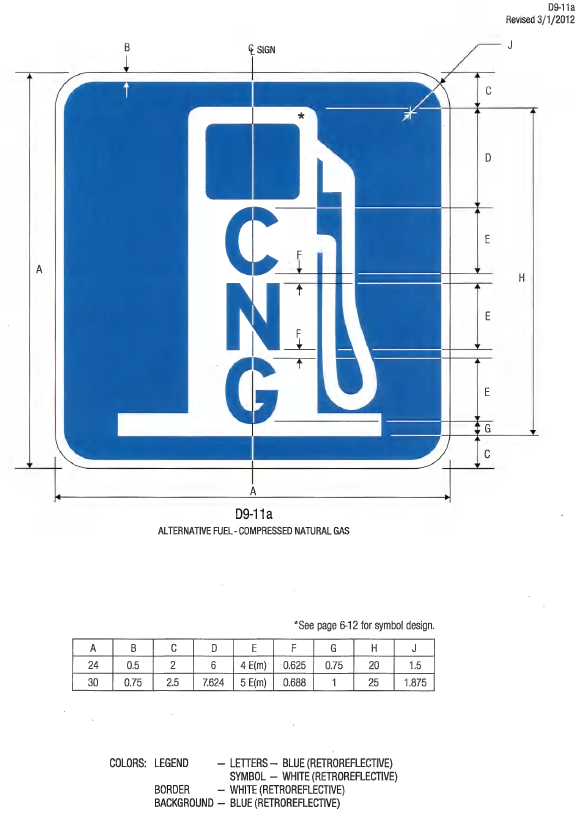| FHWA Policy Memorandums |
 |
Canceled and Superseded on February 16, 2023; Refer to Updated Version
PDF Version, 668KB
PDF files can be viewed with the Acrobat® Reader®
|
Memorandum |
| Subject: | INFORMATION AND ACTION: MUTCD — Signing for Designated Alternative Fuels Corridors |
Date: Dec 21 2016 |
| From: | Mark R. Kehrli /s/ Mark R Kehrli Director, Office of Transportation Operations |
In Reply Refer To: HOTO-1 |
| To: | Federal Lands Highway Division Engineers Division Administrators |
Purpose: Through this memorandum, the Federal Highway Administration's (FHWA) Office of Transportation Operations issues guidance to the Federal-aid Divisions regarding the signing of Alternative Fuels Corridors that have been designated by FHWA. This action does not create a mandate for the installation of signs, but rather provides guidance on the design and appropriate use of signs for Alternative Fuels Corridors. State agencies should disseminate this information to local jurisdictions for further action.
Background: Section 1413 of the Fixing America's Surface Transportation (FAST) Act required the U. S. Department of Transportation (USDOT) to designate national plug-in electric charging, hydrogen, propane, and natural gas fueling corridors in strategic locations along major highways to improve the mobility of alternative fuel vehicles. To designate the corridors, USDOT solicited nominations from State and local officials, worked with industry stakeholders, and incorporated existing fueling infrastructure. Within 5 years of the establishment of the corridors, and every 5 years thereafter, USDOT will update and re-designate the corridors. During the designation and re-designation process, USDOT will issue a report identifying charging and fueling infrastructure, analyzing standardization needs for fuel providers and purchasers, and re-establishing the goal of achieving strategic deployment of fueling infrastructure in the designated corridors by the end of 2020. See 81 F.R. No. 41, 47850 (July 22, 2016). To aid in motorist recognition of such corridors, a standard identification sign and alternative fuel General Service signs have been developed that may be used along an Alternative Fuels Corridor as provided for herein.
Authority: The Manual on Uniform Traffic Control Devices for Streets and Highways (MUTCD) is incorporated by reference in 23 CFR, Part 655, Subpart F, and shall be recognized as the national standard for all traffic control devices installed on any street, highway, bikeway, or private road open to public travel (see definition in Section 1A.13) in accordance with 23 U.S.C. 109(d) and 402(a). The policies and procedures of FHWA to obtain basic uniformity of traffic control devices shall be as described in 23 CFR 655, Subpart F.1
Sign Design and Implementation: It is essential that sound engineering principles be adhered to such as simplified message content, using reasonable sign size as specified in the provisions of this memorandum, and minimizing driver distraction through limited use of the signing and proper placement. Alternative Fuels Corridor signs shall comply with the provisions of Part 2 of the MUTCD.2
Signs for Alternative Fuels Corridors are not required. Rather, States and local authorities should determine whether to use such signs on Federally-designated Alternative Fuels Corridors. This memorandum provides the sign design and other criteria for ALTERNATIVE FUELS CORRIDOR signing.3
Alternative Fuels Corridor Identification Sign
Installation of the Alternative Fuels Corridor sign should be limited to the designated Alternative Fuels Corridor highway segment. The Alternative Fuels Corridor sign should not be displayed along a "future," "proposed," or other route where alternative fueling infrastructure is incomplete, pending, or does not currently meet the established designation criteria to qualify for signing.4 Due to the limited size of these signs, the Alternative Fuels Corridor sign shall be allowed only in post-mounted roadside installations.5
The Alternative Fuels Corridor sign assembly installation should be limited to one sign at or near the beginning of the Alternative Fuels Corridor in each direction of travel. For longer corridors, additional signs may be located beyond major intersections or major interchanges following the typical post-interchange sign sequence.6 These signs should be used sparingly as they provide limited information to drivers. The Alternative Fuels Corridor signs should not be used as directional signs or be combined with other signs, except as provided herein.
Alternative Fuels Corridor Identification Assemblies
Up to three General Service symbol signs displaying the alternative fuels available in the designated corridor may be installed below the Alternative Fuels Corridor sign, arranged horizontally (see figure 1 of this memorandum). The size of the General Service symbol signs should not exceed 18 inches when mounted with the 24-inch Alternative Fuels Corridor sign and 24 inches when mounted with the 36-inch Alternative Fuels Corridor sign. When the number of eligible alternative fuels available in the corridor exceeds three, a separate plaque with the two- or three-letter designations of each of the fuels available should be used in place of the General Service symbol signs; nonetheless, additional fuel symbols sign may also be used.
In accordance with the criteria established for the designation of Alternative Fuels Corridors,7 the General Service signs that may be posted in the Alternative Fuels Corridor sign assembly shall be limited to the following:
Compressed Natural Gas (D9-11a, MUTCD)
Liquefied Natural Gas (D9-11d, See Attachment)
Liquefied Petroleum Gas (D9-11e, See Attachment)
Hydrogen Fuel (D9-11f, See Attachment)
Electric Vehicle Charging (D9-11b alternate design provided in MUTCD Interim Approval IA-13)
Alternative Fuels supplemental plaque with the two- or three-letter designation of each of the fuels available (D9-19aP and D9-19bP, See Attachment)
The sizes of General Service signs used elsewhere in Directional Assemblies shall comply with those provided in the MUTCD.8 General Service signs for alternative fuels may be used outside of Alternative Fuels Corridors to direct motorists to alternative fuel facilities not affiliated with a designated Alternative Fuels Corridor. The General Service symbol signs for Liquefied Natural Gas (LNG), Liquefied Petroleum Gas (LPG), and Hydrogen fuel (HYD), shall be comprised of the fuel pump symbol of the D9-7 sign with the appropriate blue three-letter fuel abbreviation in a descending vertical alignment similar to the MUTCD Compressed Natural Gas (CNG) symbol sign (D9-11a).9
The beginning of an Alternative Fuels Corridor may be indicated with a BEGIN (M4-14) plaque with a white legend and border on a blue background mounted above the Alternative Fuels Corridor sign in the sign assembly.
The end of an Alternative Fuels Corridor may be indicated with an END (M4-6) plaque with a white legend and border on a blue background mounted above the Alternative Fuels Corridor sign in the sign assembly. The General Service signs should not be used in the sign assembly indicating the end of a corridor.
Directional Signing to Alternative Fuel Facilities—Freeways and Expressways
When the Alternative Fuels Corridor sign is used in a designated corridor, the applicable General Service sign(s) should be installed on the approach to an interchange from which the designated fuel services are available. If the services are not visible from the ramp of a single-exit interchange, the service signing shall be repeated at the intersection of the exit ramp and the crossroad.10 Where the alternative fuel facility is not located along the crossroad, additional General Service Directional Assemblies should be installed in advance of each subsequent turn to reach the facility.
The last availability of a particular alternative fuel type in a corridor should be indicated at the interchange on a freeway or expressway in the General Service Directional Assembly on the approach to the interchange. The LAST IN CORRIDOR (W16-19P, Attachment XX of this memorandum) warning plaque should be included in the Directional Assembly for this purpose.
Directional Signing to Alternative Fuel Facilities—Conventional Roads
General Service signs may be installed in advance of facilities located directly on the designated route directing traffic into an alternative fuel facility if the on-premise business identification signs do not clearly identify the availability of the alternative fuel.
General Service signs should be installed at turns off the designated route to direct traffic to an alternative fuel facility along a crossroad in the vicinity of the route.
General Considerations
Because regulatory, warning, and guide signs have a higher priority, installations of Alternative Fuels Corridor sign assemblies shall be limited to those locations where adequate spacing is available between the Alternative Fuels Corridor sign and other higher priority signs.11 Alternative Fuels Corridor signs shall not be installed in a location where they would obscure the road users' view of other traffic control devices or distract driver's attention from the roadway in a complex roadway environment. Alternative Fuels Corridor sign shall not be installed at any of the following locations:
The minimum spacing between Alternative Fuels Corridor signs and any other traffic control signs, except parking regulation signs, should be:
If the placement of a newly-installed, higher-priority traffic control device, such as a higher-priority sign, a highway traffic signal, or a temporary traffic control device, conflicts with an existing Alternative Fuels Corridor sign, the Alternative Fuels Corridor sign should be relocated, covered, or removed.
Conclusion: The Alternative Fuels Corridor sign may be used by States or other highway authorities to inform motorists of an Alternative Fuels Corridor highway segment designation. Alternative Fuels Corridor signs should not be used on corridors that have not been officially designated by the Secretary of Transportation. As always, safety and orderly movement of traffic must be the foremost concern when installing traffic control devices and informational signs.13
For more information regarding this topic, please contact Mr. Martin Calawa, Office of Transportation Operations, at Martin.Calawa@dot.gov.
Attachments
cc:
Associate Administrators
Chief Counsel
Chief Financial Officer
Directors of Field Services
Director of Technical Services

D18-1 Alternative Fuels Corridor Long Description

D9-11a Alternative Fuel - Compressed Natural Gas Long Description
D9-11b (Alternate) Electric Vehicle Charging (Alternate Symbol) Long Description
D9-11d Alternative Fuel - Liquefied Natural Gas Long Description
D9-11e Alternative Fuel - Liquefied Petroleum Gas Long Description
D9-11f Alternative Fuel - Hydrogen Long Description
D9-11GP Alternative 4-Fuels (Plaque) Long Description
D9-11HP Alternative 5-Fuels (Plaque) Long Description
W26-1 Last in Corridor (Plaque) Long Description
1 MUTCD Intro. ¶ 02 at I-1
2 MUTCD Intro. ¶¶ 01-03 at I-1; § 2
3 Id.
4 The FHWA's Office of Planning, Environment, and Realty has established the qualifying criteria and designations. See 81 F.R. No. 41, 47850 (July 22, 2016).
5 MUTCD § 2A.11, Table 2E-2
6 MUTCD § 2E.38, 2009 Ed.
7 23 U.S.C. § 151; Pub. L. 114-94 (Dec. 4, 2015).
8 MUTCD § 2I.02, ¶ 02-03, Fig. 2I-1 at 300-301
9 Id.; MUTCD Intro. ¶¶ 01-03 at I-1
10 MUTCD § 2I.03, ¶ 02
11 MUTCD § 2H.08, ¶ 03
12 Id.
13 MUTCD Intro. ¶¶ 01-03 at I-1; § 1A
|
United States Department of Transportation - Federal Highway Administration |
||